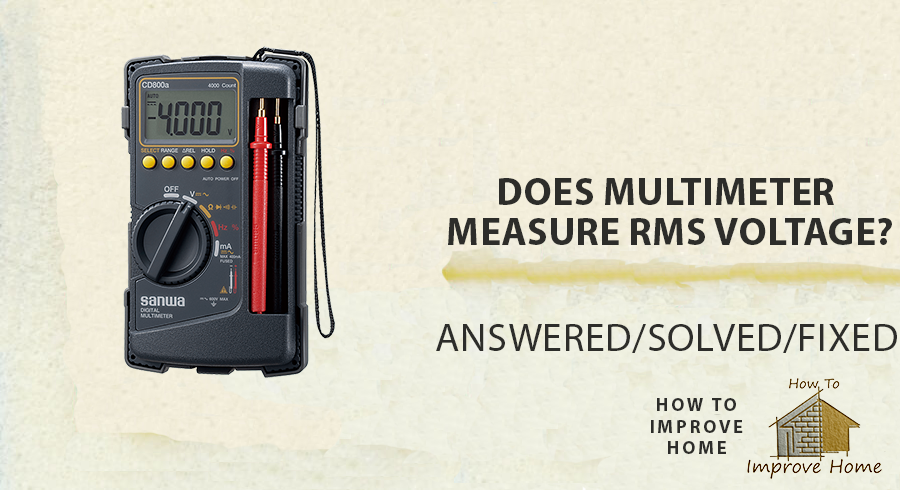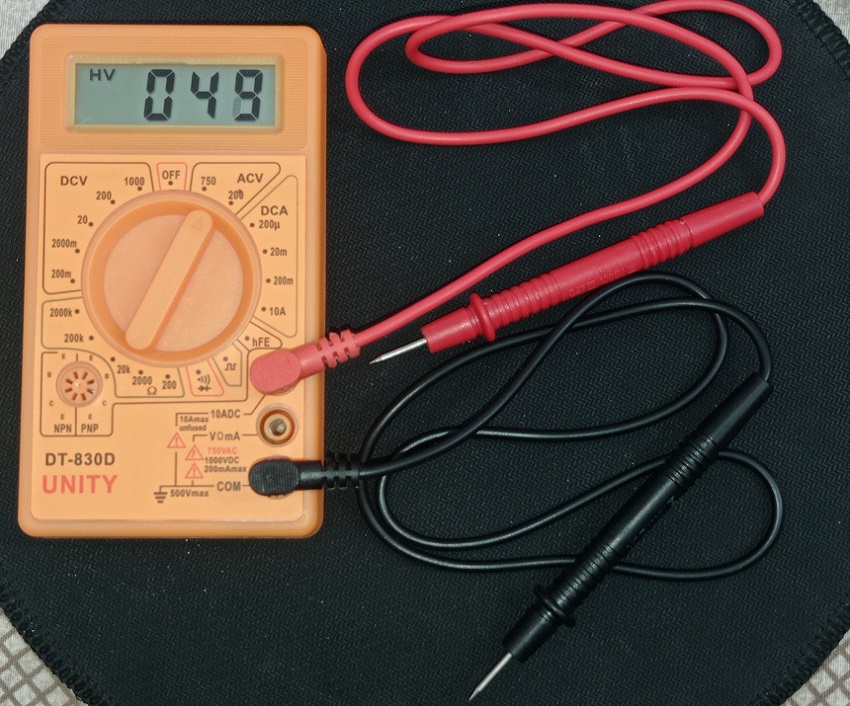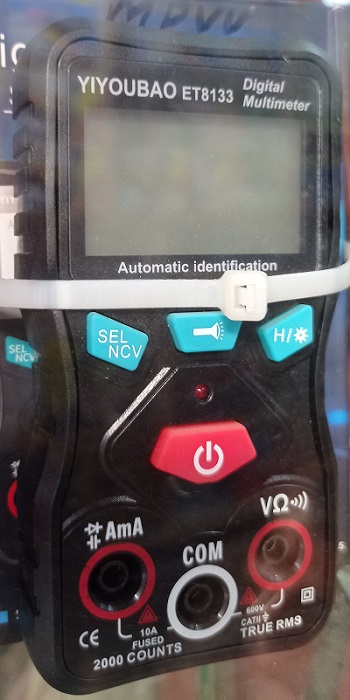When we get into the world of electricity, the voltmeter often stands out because of how many things it can do. As the name suggests, this device can measure a wide range of parameters from current to resistance and voltage. However, not all voltages are equal, giving us the Root Mean Square (RMS) strength. So, does the multimeter measure RMS voltage?
Yes, but it varies depending on the type of multimeter. There are two main kinds of multimeters, digital and analog. Digital multimeters (DMMs) are much more popular than analog ones today. They are also more accurate and have more features than their analog counterparts.
What is RMS Voltage
Before getting into the main question, it’s important to understand what RMS voltage is and how it works. Root Mean Square, or RMS, is a mathematical way to measure the size of a variable amount. It’s especially important when talking about messages that use alternating current (AC), like the power from your wall outlet.
A sinusoidal waveform shows how an AC signal changes between positive and negative numbers. If you took an average, the ups and downs would cancel each other out, giving you nothing, which isn’t very helpful.
Instead, the RMS value measures the signal’s ‘useful’ value. In other words, it gives the value of an AC input in direct current (DC). It is very helpful when figuring out power because it gives a more true picture of how much voltage is sent to a load.
The formula for calculating the RMS value of a sinusoidal waveform is:
RMS Value = Peak Value / √2
This factor, √2, is approximately 1.414.
True RMS Multimeters
Manufacturers design true RMS multimeters to accurately measure the RMS voltage of both sinusoidal (purely AC) and non-sinusoidal (square or triangular) waveforms. These are very important for electricians, engineers, and techs who work in systems with variable speed drives, HVAC, and computers, where electrical signals may not be perfectly sinusoidal. They use a complicated method that involves squaring the data, figuring out the average, and then figuring out the square root.
Average Responding Multimeters
Many multimeters, on the other hand, are “average-responding.” To estimate the RMS voltage of an AC signal, multiply the average voltage of the signal by a number, typically 1.11, for a sinusoidal waveform.
But this method only works well for sinusoidal waves. It won’t work well for waveforms that aren’t sinusoidal. These multimeters are more popular and less expensive than true RMS multimeters and can be used for many common tasks.
How to Choose a Multimeter?
When choosing a multimeter, it’s important to think about the kinds of signals you’ll be working with. If your job or hobby involves simple sinusoidal AC circuits, a voltmeter that responds on average should be enough. But professionals who work with complicated electrical systems that use signals that aren’t sinusoidal need a true RMS multimeter.
Does a DC Voltmeter Measure RMS Voltage?
From a technical point of view, a normal DC voltmeter is not made to measure RMS voltage. Using a DC voltmeter to measure AC voltage will usually give you a zero; if the AC voltage is high enough, it could break. Because a DC voltmeter only records the average DC part of the waveform, not its RMS value.
Since AC voltage often goes above and below zero, the average voltage over a full cycle is zero, so a DC voltmeter shows zero readings. But there are DC voltmeters that can also measure AC voltage because they have special circuits built in. These devices change the AC voltage into DC and then measure the average value of the resulting DC voltage.
But technically, even these DC voltmeters that have been changed do not read RMS voltage. They measure the average value of the rectified voltage, which for a sinusoidal waveform is about 0.637 times the peak voltage. It differs from the RMS value, which is about 0.707 times the peak value for a sinusoidal waveform.
A DC voltmeter is made to measure the voltage in a Direct Current (DC) connection, as its name suggests. Direct current is an electric current that always runs in the same direction, usually from high potential to low potential. Alternating Current (AC), on the other hand, changes direction and strength regularly and flows back and forth in a rhythmic pattern.
Root Mean Square (RMS) voltage is a way to measure the amount of voltage in an AC system. It shows the DC number that would give a resistor the same power as the AC voltage. You can calculate it by taking the square root of the sum of all the squares of the instantaneous volts in a single AC cycle.
Should You Use a True RMS Multimeter?
It is highly preferred to use a true RMS multimeter as it can accurately measure sinusoidal and non-sinusoidal AC waveforms, often made by electronic devices and energy-efficient lighting. Sinusoidal waveforms are found in most household and commercial power distribution systems.
The word “true” means that the readings made by the multimeter are very accurate, no matter the waveform’s shape. That is why it is considered an accurate instrument to measure the waveforms.
RMS vs. Average Responding Multimeters
A traditional average-responding multimeter uses a sinusoidal waveform to determine the RMS number. It finds the RMS value by taking the average of an AC signal and multiplying it by a factor (1.11). If the wave is indeed symmetrical, this method works well.
However, it does not operate well with non-sinusoidal waveforms, such as square, triangle, or irregular waveforms that result from electrical equipment. In these situations, the readings could be wrong by up to 40%.
A True RMS multimeter, on the other hand, records the RMS value of all waves, regardless of whether they are sinusoidal or not. It means it gets accurate readings no matter the waveform’s shape. It makes it a more reliable tool for testing loads that don’t move in a straight line, like many modern devices.
How Accurate is RMS Measurement?
RMS measurements are very accurate for the reason they were made most of the time. However, the accuracy of RMS relies on the quality of the data, the sampling rate, and the accuracy of the calculations. It gives more than the average value, so the slightest change may affect the values a lot.
RMS is very important and used a lot, especially in engineering and physics, because it gives a way to measure the size of a variable number. It is useful because it provides a unit of measurement that can be readily compared to a set amount.
For example, the RMS value is often used in the field of energy when talking about alternating currents (AC) or voltages. The RMS value is the direct current (DC) value that would heat a resistor the same amount as alternating current (AC) over a certain amount of time.
If the data that the RMS calculation is based on is noisy, has outliers, or has big mistakes, these errors will spread through the calculation and change the result. In the same way, if the data is not sampled enough or too much, this can change the RMS number.
The shape of the input wave can also change how accurate the RMS is. For example, the RMS number of a sinusoidal waveform and a square waveform are not the same. So, you need to know the signal’s waveform to figure out what the RMS number means.
If you have good data, the right sampling rate, and perform calculations with high accuracy, you can use the RMS value as a strong and accurate way to measure the magnitude of a variable number.
Note that RMS values are often more useful than averages when values change a lot or when both positive and negative values are involved because squaring the values always gives a positive value.
What is the RMS of 220v?
When we talk about the RMS of a 220V AC source, we are talking about how much DC voltage it is equivalent to. In other words, a 220V RMS AC source would give a load the same amount of power under the same conditions as a 220V DC supply. Noting that 220V is already an RMS number is important.
People usually report normal voltages in homes, businesses, and factories using RMS values. So, when we talk about a 220V AC source, we mean a voltage with an RMS value of 220V. If we want to use this RMS number to figure out the peak or peak-to-peak voltage, we will use the 2 factors from the formula we looked at earlier.
Peak Voltage = RMS Voltage * √2
So, for an AC source with 220V RMS:
Peak Voltage = 220V * 1.414 = 311V roughly
Peak-to-peak voltage is twice the peak number. It is the total voltage swing from positive peak to negative peak. So, the voltage from peak to peak for a 220V RMS source is about 622V. A voltmeter is a flexible tool that can measure many things about electricity, including voltage.
Root Mean Square (RMS) voltage is an important measure for AC circuits, and this tool can measure it. It gives a value equal to the DC voltage needed to send the same amount of power to a load.
But the type of voltmeter makes a difference. True RMS multimeters can measure RMS voltage correctly for both sinusoidal and non-sinusoidal waveforms. It makes them very important for people who work with systems like variable speed drives, HVAC, and computers where the electrical data may not be perfectly sinusoidal.
On the other hand, average responding multimeters are more popular and cheaper. They figure out the RMS voltage by multiplying the average voltage of an AC signal by a factor. This method works well for waves that are sinusoidal, but it might not work for waves that aren’t sinusoidal.
However, a normal DC voltmeter cannot measure RMS voltage as it only measures the average value of the DC part of the waveform, not its RMS value. Still, some DC voltmeters with special circuits can measure AC voltage by turning it into a form of DC.
So, it’s important to think about the kinds of signals you’ll be working with when picking a multimeter. A voltmeter that responds on average should be enough if you are working with simple linear AC circuits. But you need a true RMS multimeter if you are working with complicated electrical systems that do not use sinusoidal signals.
Conclusion
A voltmeter is a flexible tool that can measure many things about electricity, including voltage. Root Mean Square (RMS) voltage is an important measure for AC circuits, and this tool can measure it. It gives a value equal to the DC voltage needed to send the same amount of power to a load.
But the type of voltmeter makes a difference. True RMS multimeters can measure RMS voltage correctly for both sinusoidal and non-sinusoidal waveforms. It makes them very important for working with systems like variable speed drives, HVAC, and computers where the electrical data may not be perfectly sinusoidal.
On the other hand, average responding multimeters are more popular and cheaper. They figure out the RMS voltage by multiplying the average voltage of an AC signal by a factor. This method works well for sinusoidal waves, but it might not work for waves that aren’t sinusoidal.
However, a normal DC voltmeter cannot measure RMS voltage because it only measures the average value of the DC part of the waveform, not its RMS value. Still, some DC voltmeters with special circuits can measure AC voltage by turning it into a form of DC.
So, it’s important to think about the kinds of signals you’ll be working with when picking a multimeter. A voltmeter that responds on average should be enough if you are working with simple linear AC circuits. But you need a true RMS multimeter if you are working with complicated electrical systems that do not use sinusoidal signals.










